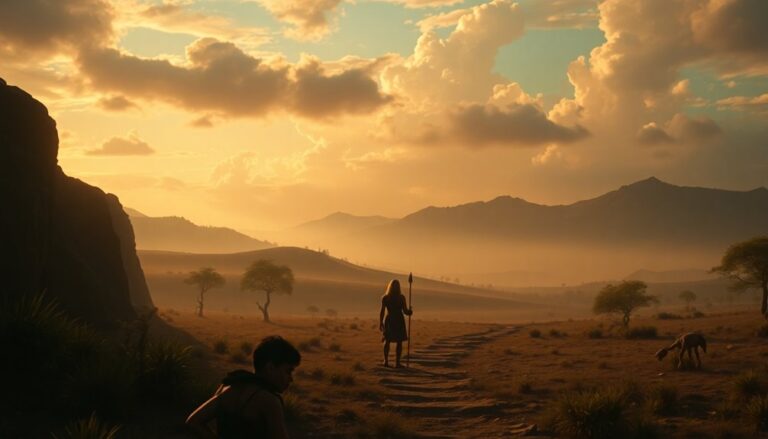The first person on Earth is commonly regarded as Adam, who plays a significant role in religious texts. In the Bible, he's created by God from dust and placed in the Garden of Eden. In Islamic tradition, Adam is seen as the first human and prophet, created from diverse soils and tasked with building the Kaabah. However, from a scientific perspective, early human ancestors like *Homo sapiens* emerged in Africa about 300,000 years ago. The blend of these narratives and scientific findings offers fascinating insights into humanity's beginnings. Keep exploring to uncover more intriguing aspects of our origins.
Essential Insights
- In biblical accounts, Adam is considered the first human created by God, placed in the Garden of Eden.
- Islamic tradition also recognizes Adam as the first human and prophet, created from diverse soils.
- Evolutionary science identifies *Homo sapiens* as the first modern humans, appearing around 300,000 years ago in Africa.
- Early human ancestors, like *Homo habilis* and *Homo erectus*, contributed to the evolution of modern humans over millions of years.
- Genetic evidence indicates that all modern humans share a common ancestry traced back to Africa, supporting the recent African origin theory.
Biblical Account of Adam

In the biblical account, Adam is often regarded as the first human created by God, uniquely formed from the dust of the ground. His creation is significant; God breathed life into him, making him a living soul in His image and likeness. This divine act establishes Adam not just as a creature, but as a reflection of God's glory.
Placed in the Garden of Eden, Adam enjoyed an Edenic life filled with beauty and abundance. He had access to all the trees, except for one—the Tree of the Knowledge of Good and Evil. This paradise was home not only to lush vegetation but also to a variety of animals. God brought these creatures to Adam, and he named each one, showcasing his dominion over the earth and its inhabitants. Additionally, Adam was given authority over the creatures of the earth, reflecting his unique role in creation.
As a companion, God created Eve from one of Adam's ribs, forming a bond that emphasized partnership and love. Together, they lived harmoniously until the fateful moment they ate the forbidden fruit. This act of disobedience brought sin and death into the world, leading to their expulsion from the Garden.
Despite the consequences of his actions, Adam's legacy continued through his sons, Cain, Abel, and Seth. His life and decisions serve as a pivotal foundation for understanding human history and the need for redemption, marking him as an essential figure in biblical narratives.
Adam stands as the father of all humankind, setting the stage for the unfolding story of humanity.
Adam in Islamic Tradition

Adam holds a central place in Islamic tradition as the first human and prophet, embodying the beginning of humanity's relationship with Allah. His creation is unique; Allah fashioned him from a handful of earth gathered from various parts of the world, using soil of different colors to represent the diversity of humanity. This act of creation signifies Adam's significance as a vicegerent on Earth, a role that underscores the responsibility humans hold in their relationship with God.
You see, Adam wasn't just created; he was given life when Allah breathed a soul into him. His interaction with the angels is pivotal. They were commanded to prostrate to him, a demonstration of his importance, except for Iblis, who refused. This refusal set the stage for the ongoing struggle between good and evil. Adam's creation from dust symbolizes humanity's earthly identity, reinforcing the connection between Adam and the earth.
Upon coming to life, Adam praised Allah, establishing a foundation for gratitude and reverence. Adam's legacy extends beyond his life. He built the first Sanctuary, the Kaabah, and introduced the ritual of Hajj, shaping the spiritual practices of future generations.
After his fall, Adam repented and was forgiven, highlighting the themes of mercy and redemption in Islam. Living to the age of 930, he'd many descendants, embodying the biological evolution of humankind as told in the Quran. His story serves not only as a religious narrative but also as a symbol of the diverse origins of humanity, reflecting the richness inherent in Adam's creation.
Early Human Ancestors
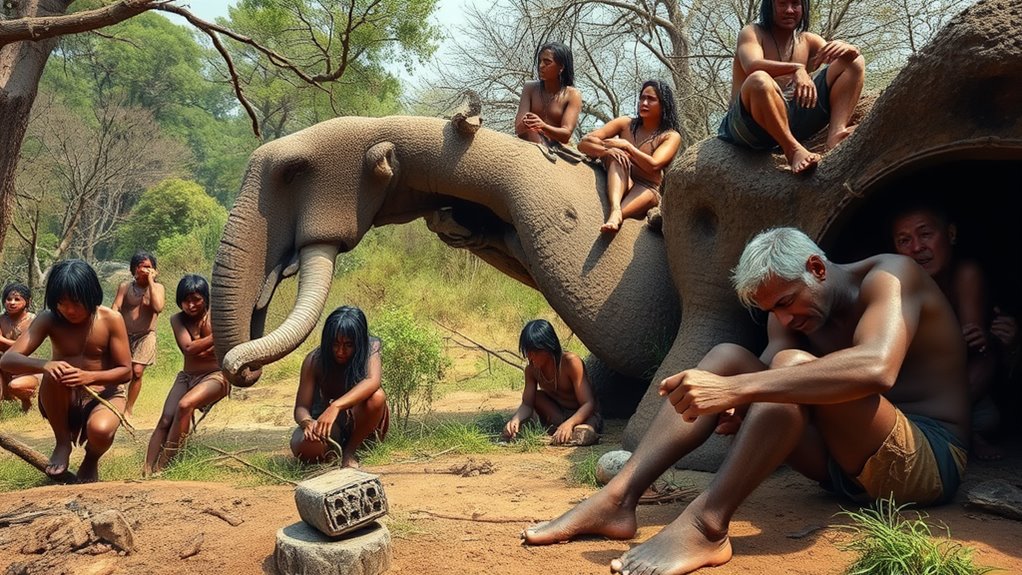
The journey of early human ancestors is a compelling tale of evolution and adaptation. Understanding this journey involves examining the various stages of hominin adaptations and their remarkable ability to innovate, particularly in tool evolution. Early primates diverged from other mammals around 85 million years ago, leading to the emergence of hominins roughly 8 to 9 million years ago. From there, a significant shift occurred with the appearance of *Homo habilis* around 2.8 million years ago, marking the dawn of tool use.
Here's a quick overview of key milestones in early human evolution:
| Milestone | Description |
|---|---|
| Emergence of *Homo habilis* | First known species to use stone tools |
| Development of *Homo erectus* | Introduced complex tools and fire, migrated out of Africa |
| Rise of *Homo heidelbergensis* | Lived in multiple regions, showcasing diverse adaptations |
These early hominins demonstrated remarkable cognitive developments, with brain sizes gradually increasing to support complex thought and social structures. The evolution of tools not only enhanced their survival but also reflected their adaptability to changing environments. The lineage leading to modern humans includes several key species, highlighting the importance of bipedalism and tool-making in shaping our evolutionary path.
As you explore further into this intriguing history, remember that every innovation and adaptation brought our ancestors one step closer to the species we are today. Each tool they crafted and each migration they undertook was part of an intricate dance of survival and evolution, setting the stage for the emergence of modern humans.
Origins of Homo Sapiens
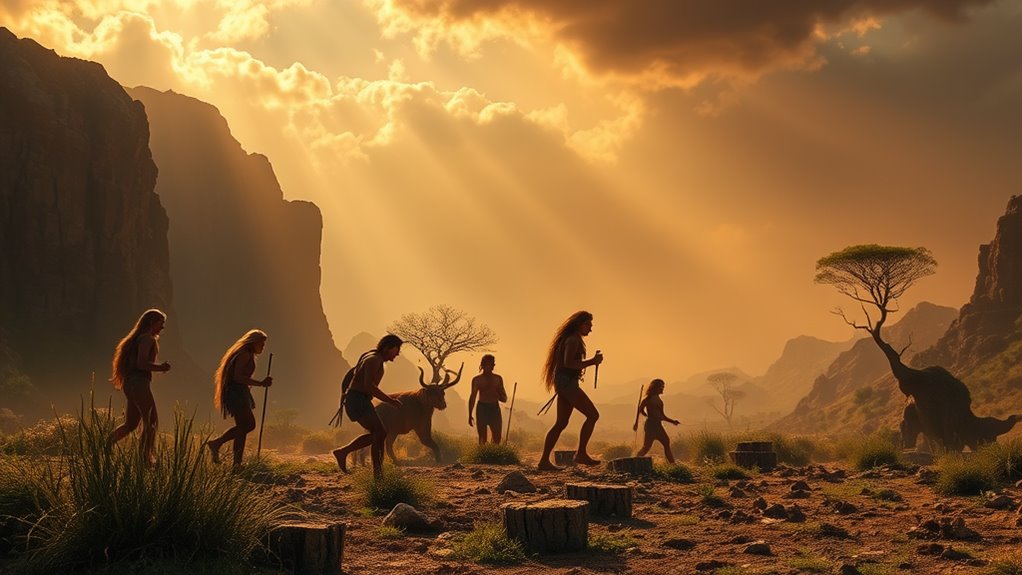
Understanding the origins of Homo sapiens reveals a fascinating chapter in human history that traces back to Africa between 300,000 and 200,000 years ago. Fossil discoveries across the continent, particularly in Morocco, South Africa, and East Africa, highlight a complex origin story. The 300,000-year-old fossils found at Jebel Irhoud, Morocco, provide early evidence of modern traits mixed with archaic features, such as elongated brain cases. This period also saw an increase in brain size, which may have contributed to enhanced cognitive abilities.
You'll find that the emergence of Homo sapiens likely involved a pan-African event, with diverse groups mixing and exchanging genes. Climate-driven changes facilitated this diversity, impacting cultural practices as well. Genetic analysis shows that these early humans had cranial capacities similar to modern humans and exhibited sophisticated tool use, including advanced stone tools and handaxes.
As Homo sapiens began migrating, they ventured outside Africa as early as 177,000 to 194,000 years ago, with small groups leaving around 100,000 years ago in slow waves. Climate changes played an essential role in shaping migration patterns, creating green corridors that connected Africa to Eurasia.
During this period, Homo sapiens coexisted with other hominin species, such as Neanderthals. Genetic evidence of interbreeding suggests that these interactions were common, leading to complex relationships marked by competition and cultural exchange.
Ultimately, while other hominins disappeared, Homo sapiens emerged as the sole surviving human species, shaping the world as we understand it today.
Fossil Evidence of Early Humans

Fossil evidence plays an essential role in unraveling the story of early humans and their evolution. When you examine these fossils, you uncover significant insights into our ancient habitats and the characteristics of early *Homo sapiens*.
For instance, the Jebel Irhoud site in Morocco holds the oldest known *Homo sapiens* fossils, dating back between 350,000 and 280,000 years. These fossils exhibit a fascinating blend of modern and archaic traits, such as a longer, lower braincase paired with delicate cheekbones. Recent research using advanced dating methods has revealed that these fossils are even older than previously thought.
The Omo Kibish Formation in Ethiopia contributes further to our understanding, housing the Omo I remains, which are now pegged to be older than 230,000 years. These remains showcase unequivocal modern human features, including a tall cranial vault and a distinct chin.
Early *Homo sapiens* skulls reveal developmental characteristics, bridging the gap between primitive and modern forms.
The significance of these fossils extends beyond mere anatomy. Associated artifacts, like Middle Stone Age tools and evidence of fire use, indicate complex behaviors among early humans.
You'll find cut marks on animal bones from prey such as gazelles and wildebeests, suggesting that these early beings engaged in hunting and resource utilization.
As you piece together this fossil evidence, you gain a clearer picture of the evolutionary narrative, highlighting how ancient environments shaped the development of early humans.
Evolutionary Timeline Overview
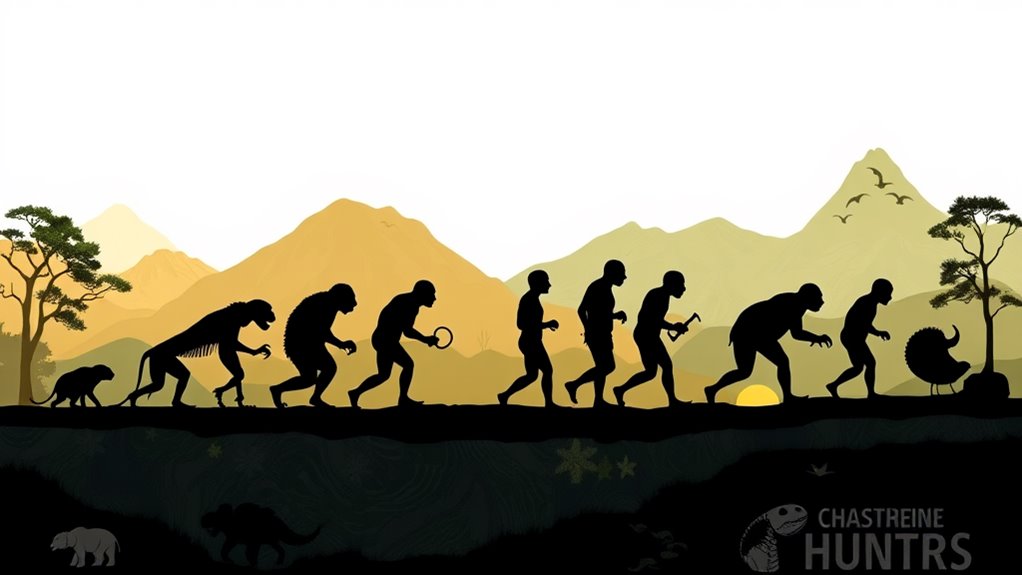
As you explore the evolutionary timeline of humans, you'll discover a fascinating journey that spans millions of years. It all begins around 7 million years ago with the emergence of basal hominins, the first steps toward our lineage.
By 6 million years ago, early humans had developed a bipedal adaptation, allowing them to walk upright on short legs. This adaptation was essential as it set the stage for further evolution, including the broad knee joints found in fossils from 4.1 million years ago that indicate regular bipedal walking.
By 2.8 million years ago, the *Homo* genus emerged with *Homo habilis*, who began using stone tools, marking a significant technological advancement. The timeline shows a pattern of hominin migration, as early humans left Africa around 1.8 million years ago, spreading into Asia and Europe.
*Homo erectus*, living between 1.7 million and 200,000 years ago, exemplified this migration while also showcasing advanced tool-making skills. Additionally, during this period, the development of Acheulean tools around 1.7 million years ago marked a turning point in human technological innovation.
Around 300,000 years ago, anatomically modern humans appeared in Africa, and by 60,000 to 40,000 years ago, they began to migrate globally. This period also saw the development of cultural artifacts like paintings and figurines, reflecting sophisticated cognitive abilities.
Each milestone in this evolutionary timeline highlights the significance of bipedal adaptation and the relentless journey of hominin migration, shaping the very essence of what it means to be human today.
Cultural Development of Early Humans

Throughout early human history, cultural development played an essential role in shaping societies. You'll notice that tool innovation was one of the key drivers of this transformation. Early humans created basic tools around 2.6 million years ago, leading to significant advancements like hand-axes and chipped stone technology. These tools not only aided in hunting but also reflected the social adaptations of early hunter-gatherer groups as they followed migrating herds.
As you explore this period, you'll see how cultural exchange among groups enhanced technological development. Archaeological findings from places like Blombos Cave reveal that early humans shared ideas and practices, fostering innovation. The symbolic communication expressed through engravings and decorative objects highlights the importance of cultural exchange in human societies.
You might find it fascinating that by around 60,000 years ago, modern humans began to create permanent drawings, signaling a leap in symbolic expression. This ability to communicate complex ideas laid the groundwork for social cohesion and cultural identity.
Furthermore, as societies shifted from nomadic lifestyles to more sedentary ones, the adoption of ground stone technology allowed for pottery and grain cultivation. This change marked a significant alteration in social structures and daily life.
Genetic Diversity in Human Evolution
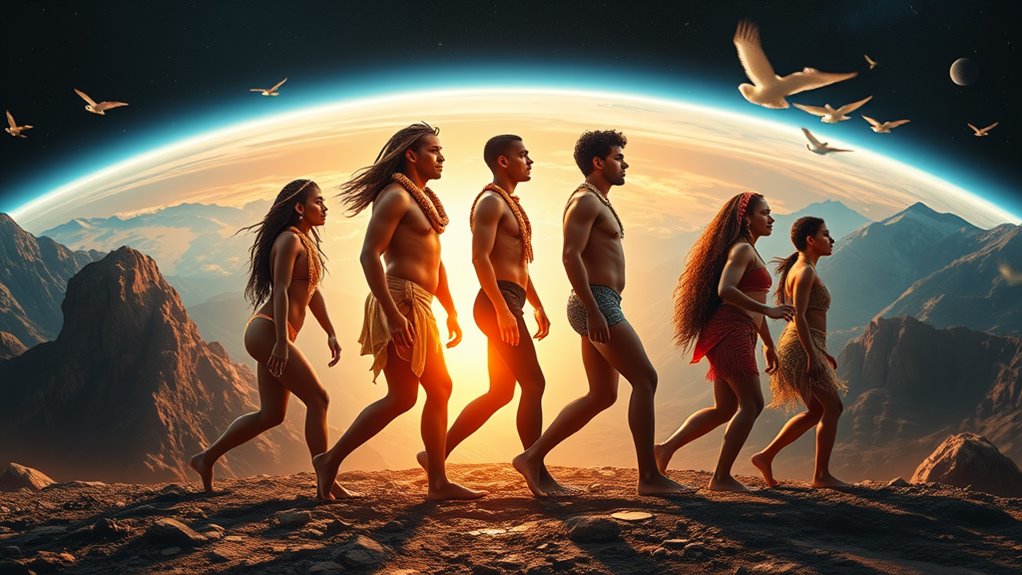
Cultural development in early human societies laid the groundwork for understanding genetic diversity in human evolution. You'll find that no two humans are genetically identical, with about 85% of genetic variation existing within populations. This genetic variation often comes in the form of small differences, like single nucleotide polymorphisms (SNPs) and brief insertions or deletions (indels). Curiously, structural variations contribute even more base-pairs than SNPs and indels combined.
Geographic distribution plays a significant role in population genetics. For instance, genetic variation among local populations within the same continent accounts for roughly 7% of total variation, while variation between distinct continents accounts for about 8%. African populations are particularly significant; they typically exhibit higher genetic diversity and intricate population substructures. As you move away from Africa, genetic diversity tends to decrease, supporting the recent African origin theory.
While humans show less genetic diversity compared to species like rhesus macaques and chimpanzees, the homogeneity of human genetics is striking. Approximately 15% of genetic variants are unique to specific geographic areas.
Understanding genetic variation not only helps reconstruct our evolutionary history but also sheds light on the genetic basis of human diseases. Key evolutionary forces like genetic drift, mutation, migration, and selection have all shaped our genetic landscape, emphasizing the importance of studying diverse populations to grasp the full picture of human evolution.
Frequently Asked Questions
What Evidence Do We Have for Adam's Existence?
Think of historical texts and archaeological findings as puzzle pieces, each offering clues about Adam's existence.
While biblical accounts depict Adam as the first man, there's no direct scientific evidence to confirm this.
Historical texts refer to him consistently, while archaeological findings support the gradual evolution of humans.
You see, the narrative of Adam shapes theology, but it doesn't align with the evidence we gather from science, which tells a different story.
How Do Different Cultures Interpret the Story of Adam?
Different cultures interpret the story of Adam through various cultural narratives and symbolic interpretations.
In Christianity, he symbolizes humanity's fall and redemption, while in Islam, he's revered as a prophet emphasizing humility.
These narratives reflect shared themes of creation and moral lessons. You can see how Adam's story influences literature and art, representing universal human experiences.
Each culture shapes his legacy, highlighting diverse understandings of existence and identity.
What Role Does Mythology Play in Human Origins?
Think of the stories you grew up with, where gods shaped the world like clay.
Mythology plays an essential role in human origins, weaving mythological narratives that reflect cultural symbolism. These tales not only explain how life began but also connect people to their heritage and values.
They shape your understanding of existence, instilling a sense of belonging and identity, all while revealing deeper truths about the human experience.
How Do Religious Beliefs Affect Scientific Interpretations of Human Evolution?
Religious beliefs greatly shape your scientific interpretations of human evolution.
Faith perspectives can either embrace or challenge evolutionary theory, leading to ongoing evolution debates. For instance, some may see evolution as compatible with their beliefs, while others may interpret sacred texts literally, causing conflict.
This interplay influences how you understand human origins and can affect educational approaches, as you navigate the balance between science and faith in discussions about humanity's beginnings.
Are There Contradictions Between Religious Texts and Scientific Findings?
Imagine a grand tapestry woven with threads of belief and knowledge.
When you engage in textual analysis of religious texts, you often find stories that clash with scientific findings. The historical context reveals that while faith speaks of creation, science narrates evolution.
This divergence invites you to explore deeper, recognizing that contradictions exist not just in words but in the very fabric of understanding, challenging you to reconcile these different threads of wisdom.
